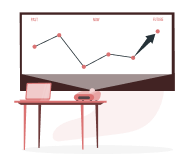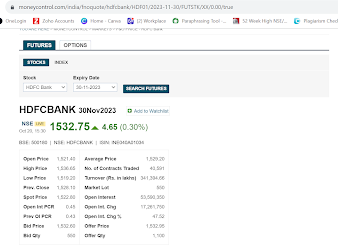What is Open Interest in Options?
5paisa Research Team
Last Updated: 24 Jun, 2024 02:27 PM IST

Content
- Key Takeaways
- Key Points
- Differences Between Open Interest and Trading Volume
- Benefits of Using Open Interest and Trading Volume Data
- How do traders use open interest data in their trading strategies?
- Open Interest Indicators
- Conclusion
Open Interest (OI) is a crucial concept in the world of futures and options trading. A futures contract binds the buyer to buy and the seller to sell and deliver a certain asset at a predetermined future date. An option allows the buyer the choice to purchase (or sell) an asset at a predetermined price at any point during the term of the contract, but it does not obligate them to do so.
Open Interest represents the total number of contracts that are currently held by market participants and have not yet been offset by closing trades. Unlike trading volume, which measures the number of contracts traded during a specific period, open interest focuses on the total number of contracts that are still "open" or outstanding.
Open Interest (OI) is a metric that quantifies the total number of futures or options contracts actively in circulation within the market. It's important to note that every trade involves two parties: a buyer and a seller. For instance, when a seller offers and a buyer acquires a single contract, the buyer holds a long position in that contract, while the seller takes a short position. In this scenario, the open interest is recorded as 1, signifying the existence of an active contract on the market.
To illustrate this concept, let's consider an example:
Example:
Imagine you are observing the futures market for gold contracts. Each gold futures contract represents the obligation to buy or sell a specific amount of gold at a predetermined price and date in the future. In this example, we'll focus on the open interest for gold futures contracts.
Day 1:
Morning: The gold futures market starts the day with zero open interest.
Trader X decides to buy 5 gold futures contracts, and Trader Y simultaneously decides to sell 5 gold futures contracts. This means Trader X is now "long" 5 contracts, and Trader Y is now "short" 5 contracts.
Calculations at the end of Day 1:
Open Interest: 5 contracts (because there are 5 contracts that are still open, as Trader X and Trader Y have not offset their positions).
Trading Volume for the day: 10 contracts (5 bought by Trader X and 5 sold by Trader Y ).
| Day 1 | |||
| Trader | Buy | Sell | Contracts held |
| X | 5 | 5 | |
| Y | 5 | 5 | |
| Z | |||
| OI | 5 | ||
Day 2:
Morning: The market opens with an open interest of 5 contracts (carryover from Day 1) and a trading volume of zero.
Trader Z enters the market and buys 10 gold futures contracts.
Calculations at the end of Day 2:
Open Interest: 15 contracts (5 from Day 1 + 10 bought by Trader Z).
Trading Volume for the day: 10 contracts (all bought by Trader Z).
| Day 1 | Day 2 | |||||
| Trader | Buy | Sell | Contracts held | Buy | Sell | Contracts held |
| X | 5 | 5 | ||||
| Y | 5 | 5 | ||||
| Z | 10 | 10 | ||||
| OI | 5 | 15 |
Day 3:
Morning: The market opens with an open interest of 15 contracts (carryover from Day 2) and a trading volume of zero.
Trader W decided to sell 7 gold futures contracts.
Calculations at the end of Day 3:
Open Interest: 22 contracts (15 from Day 2 +7) sold by Trader W).
Trading Volume for the day: 7 contracts (all sold by Trader W).
| Day 1 | Day 2 | Day 3 | |||||||
| Trader | Buy | Sell | Contracts held | Buy | Sell | Contracts held | Buy | Sell | Contracts held |
| X | 5 | 5 | |||||||
| Y | 5 | 5 | |||||||
| Z | 10 | 10 | |||||||
| W | 7 | 7 | |||||||
| OI | 5 | 15 | 22 |
Day 4:
Morning: The market opens with an open interest of 22 contracts (carryover from Day 3) and a trading volume of zero.
No new trades occur during the day; all positions remain unchanged.
Calculations at the end of Day 4:
Open Interest: 22 contracts (no change from the morning since there were no new trades).
Trading Volume for the day: Zero.
| Day 1 | Day 2 | Day 3 | Day 4 | |||||||||
| Trader | Buy | Sell | Contracts held | Buy | Sell | Contracts held | Buy | Sell | Contracts held | Buy | Sell | Contracts held |
| X | 5 | 5 | ||||||||||
| Y | 5 | 5 | ||||||||||
| Z | 10 | 10 | ||||||||||
| W | 7 | 7 | ||||||||||
| OI | 5 | 15 | 22 | 22 |
More About Derivatives Trading Basics
- test123
- Guidance to Futures and Options Trading in the Stock Market
- Covered Call
- What Is Put Writing?
- Delta Hedging
- Credit Spread
- Currency Options
- Options Hedging Strategy
- Options And Futures: Understand The Functioning, Types and Other Factors
- Options Trading for Beginners: A Comprehensive Guide For You
- Best Options Trading Courses: Things To Know About
- Short Strangle: How Does It Work In 2023
- Butterfly Option Strategy
- Options Selling
- What Are Stock Options: A Complete Guide 2023
- What is the Call and Put Option?
- What are Futures and Options?
- What is Implied Volatility?
- What is Open Interest in Options?
- What is Strike Price?
- What Is a Call Option?
- What is a Put Option?
- How to Choose Best Stocks for Option Trading?
- Options Trading Tips
- How to Trade Options?
- Types of Options
- Understanding Various Options Trading Strategies
- What are Options?
- What is Put-Call Ratio?
- What is Margin Money?
- What is an Open Interest?
- Call Options Basics and How it Works?
- The Simplest Guide to Futures Pricing Formula
- What are Bullish Option Strategies?
- What are the Various Types of Derivatives?
- What is Bermuda Option?
- What are Swaps Derivatives?
- What is an Index Call? Overview of Index Call Options
- What is Forward Market?
- What is Option Volatility & Pricing Strategies for Advanced Trading
- What is Settlement Procedure?
- What is Margin Funding?
- Derivatives Trading in India
- Difference Between Equity and Derivatives
- What are Currency Derivatives?
- Derivatives Advantages & Disadvantages
- What are Forward Contracts?
- How to Trade in Futures and Options?
- What is Meant by Futures in Trading?
- Stock Index Futures
- Stocks vs Futures
- What Are Exchange Traded Derivatives?
- Futures Contract: Meaning, Definition, Pros & Cons
- What is Options Trading?
- What is Derivative Trading?
- What are Derivatives?
- Straddle Strategy
- Options Strategies
- Hedging Strategy
- Difference Between Options and Futures Read More
Disclaimer: Investment in securities market are subject to market risks, read all the related documents carefully before investing. For detailed disclaimer please Click here.
Frequently Asked Questions
Open Interest: Represents the total number of open contracts on a security. It reflects active positions that haven’t been settled. Updated once per day.
Volume: Measures the number of trades completed daily. High volume indicates interest and liquidity. Both metrics help confirm trends and reversals.
Increasing Open Interest: New money entering the market, suggesting trend continuation.
Decreasing Open Interest: Traders exiting positions, signaling potential trend reversal.
Combine with price action and volume for better insights.
Check the CME Group’s website for specific assets (e.g., corn futures). Navigate to the settlements page to compare open interest from different days.



